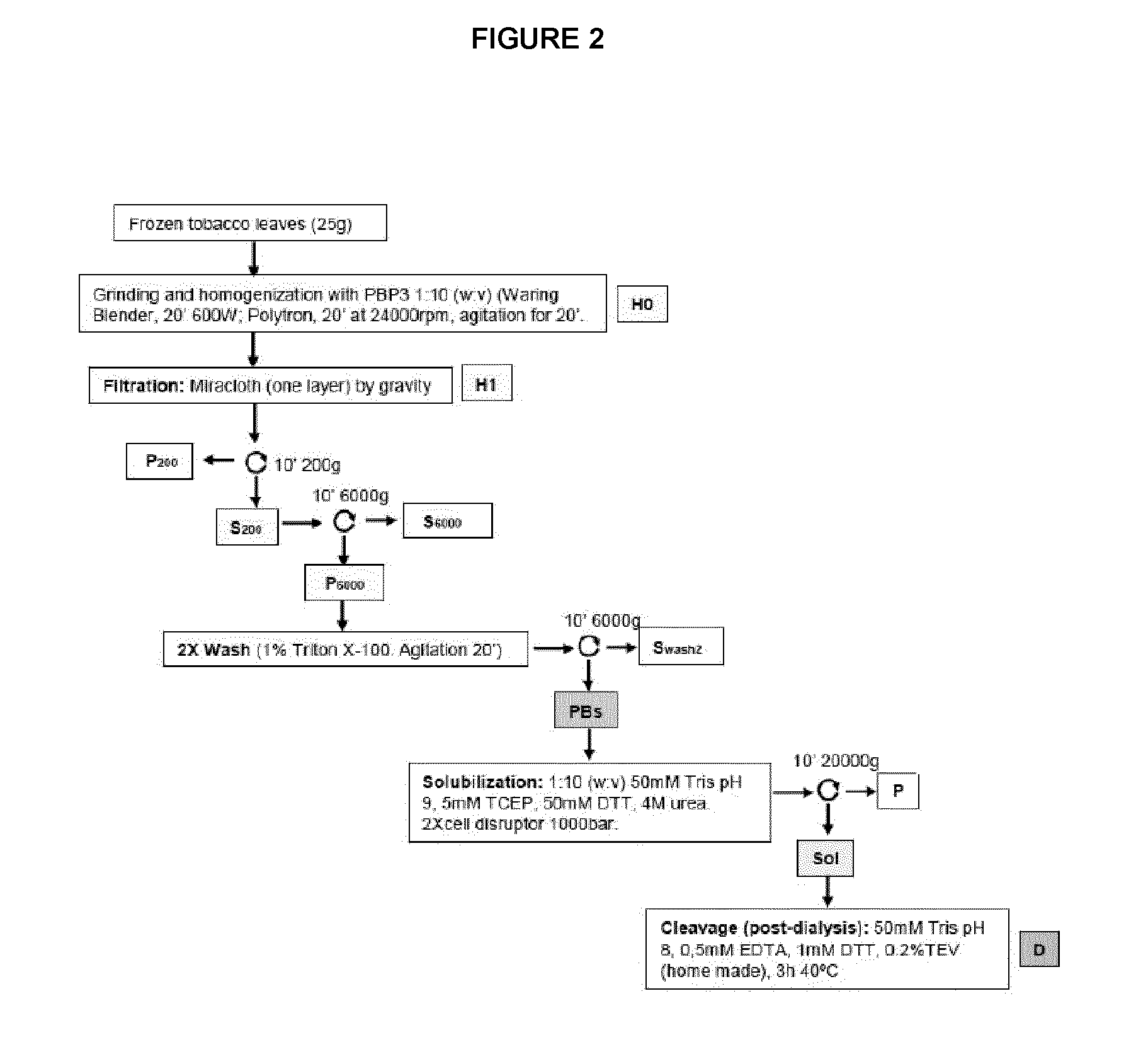Method for producing mullerian inhibitor substance in plants
a technology of mullerian and plant, applied in the field of mullerian inhibitor substances, can solve the problems of increased loss of ovarian follicles, premature cessation of ovarian cycling, and difficult development of plant based production systems, and achieves easy scalable mass production of protein, high efficiency of mis expression, and easy recovery of recombinant mis fusion protein
- Summary
- Abstract
- Description
- Claims
- Application Information
AI Technical Summary
Benefits of technology
Problems solved by technology
Method used
Image
Examples
example 1
Materials & Methods
[0133]Cloning and Infiltration
[0134]Nucleic acid constructs comprising nucleotide sequences encoding gamma-zein wild type gene, fragments and variants thereof are each ligated to a synthetic sequence encoding mature MIS. Where a fragment or variant of gamma-zein is used, the nucleic acid construct further comprise a nucleotide sequence encoding the native gamma-zein signal peptide at the 5′ end if it is present in the fragment or variant. For certain experiments, a synthetic nucleic acid sequence encoding a linker comprising a protease cleavage site is also included in the construct, positioned between the gamma-zein and MIS coding sequences. The coding sequence of mature MIS has been optimized for expression in plants. The nucleic acid constructs are cloned into a vector at a site where a min35S promoter drives expression of the nucleic acid construct in tobacco plant cells.
[0135]Vectors comprising the cloned nucleic acid constructs are introduced into Agrobacter...
example 2
Expression Levels of MIS-Gamma-Zein Fusion Protein
[0149]A gamma-zein-Enterokinase-MIS fusion protein construct (gamma-zein-MIS) is introduced into tobacco plants using Agrobacterium agroinfiltration. Total protein is extracted and quantified by Western blot using gamma-zein-specific antibody. A control experiment using MIS expressed under the same conditions without gamma-zein is also carried out (MIS). Expression levels from the average of four agroinfiltration events are as follows.
[0150]For gamma-zein-MIS, the expression levels are between about 0.2 and 0.6 g gamma-zein-MIS / kg fresh weight.
[0151]For MIS without gamma zein, the expression levels are between about 0.1 and 0.3 g gamma-zein-MIS / kg fresh weight.
[0152]Based on these average results, it is concluded that the expression of gamma-zein-MIS is about 30 times higher than the expression level without gamma-zein.
example 3
Analysis of Different Non-Naturally Occurring Repeat Motifs in Gamma-Zein
[0153]Gamma-zein-MIS fusion constructs are prepared using different non-naturally occurring repeat motifs in gamma-zein. The following constructs are tested: gamma-zein peptide only (gamma-zein-wt); gamma-zein with an (PPPVAL)n repeat motif; gamma-zein with a (PPPVEL)n repeat motif; gamma-zein with a (PPPAPA)n repeat motif and gamma-zein with a (PPPEPE)n repeat motif.
[0154]The constructs are separately infiltrated into different Tobacco plants using Agrobacterium agroinfiltration. Total protein is extracted and quantified by Western blot using gamma-zein-specific antibody. Expression levels from the average of two agroinfiltration events relative to gamma-zein-wt are as follows:
Construct testedExpression levelGamma-zein-wt1.0Gamma-zein-(PPPVAL)n0.75Gamma-zein-(PPPVEL)n7.81Gamma-zein-(PPPAPA)n6.97Gamma-zein-(PPPEPE)n2.75
[0155]Three out of the five constructs tested (gamma-zein-Glu, gamma-zein-(PPPAPA)n, and gamm...
PUM
| Property | Measurement | Unit |
|---|---|---|
| density | aaaaa | aaaaa |
| diameters | aaaaa | aaaaa |
| pH | aaaaa | aaaaa |
Abstract
Description
Claims
Application Information
 Login to View More
Login to View More - R&D
- Intellectual Property
- Life Sciences
- Materials
- Tech Scout
- Unparalleled Data Quality
- Higher Quality Content
- 60% Fewer Hallucinations
Browse by: Latest US Patents, China's latest patents, Technical Efficacy Thesaurus, Application Domain, Technology Topic, Popular Technical Reports.
© 2025 PatSnap. All rights reserved.Legal|Privacy policy|Modern Slavery Act Transparency Statement|Sitemap|About US| Contact US: help@patsnap.com


